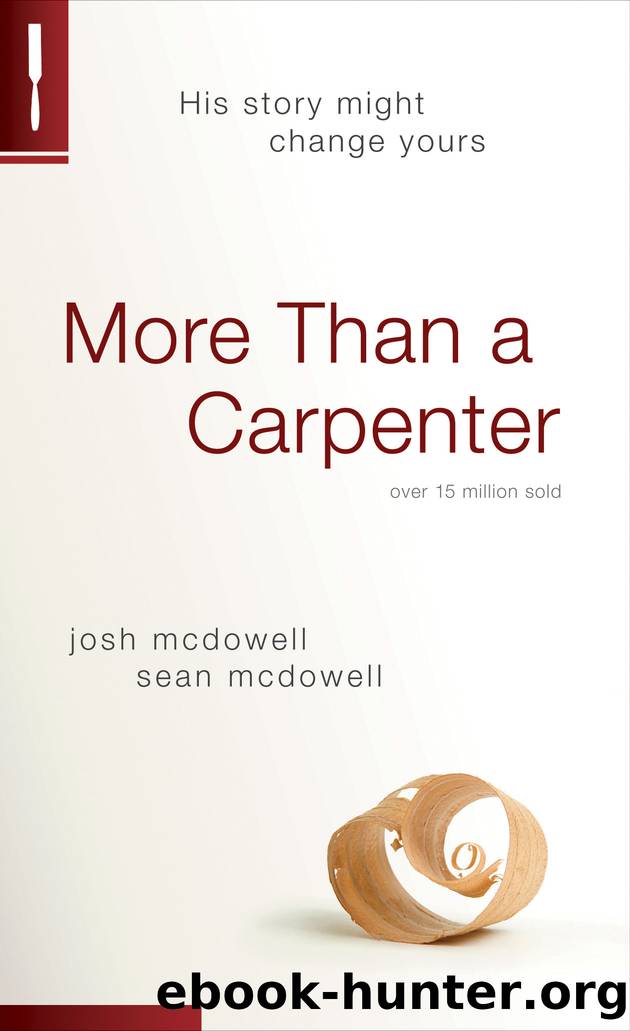More Than a Carpenter by Josh D. McDowell & Sean McDowell

Author:Josh D. McDowell & Sean McDowell
Language: eng
Format: epub
Tags: RELIGION / Christian Life / Spiritual Growth, RELIGION / Christian Theology / Apologetics
Publisher: Tyndale House Publishers, Inc.
Published: 2009-05-06T00:00:00+00:00
External Evidence Test
The third test of historicity is that of external evidence. The issue here is whether other historical material confirms or denies the internal testimony of the documents themselves. In other words, what sources, apart from the literature under analysis, substantiate the documentâs accuracy, reliability, and authenticity?
Louis Gottschalk argues that âconformity or agreement with other known historical or scientific facts is often the decisive test of evidence, whether of one or more witnesses.â[35]
Two friends and disciples of the apostle John confirm the internal evidence that appears in Johnâs accounts. The first was Papias, bishop of Hierapolos (AD 130). The historian Eusebius preserves the writings of Papias as follows:
The Elder [apostle John] used to say this also: âMark, having been the interpreter of Peter, wrote down accurately all that he [Peter] mentioned, whether sayings or doings of Christ, not, however, in order. For he was neither a hearer nor a companion of the Lord; but afterwards, as I said, he accompanied Peter, who adapted his teachings as necessity required, not as though he were making a compilation of the sayings of the Lord. So then Mark made no mistake, writing down in this way some things as he mentioned them; for he paid attention to this one thing, not to omit anything that he had heard, not to include any false statement among them.â[36]
The second friend of John was one of his disciples, Polycarp, who became bishop of Smyrna and had been a Christian for eighty-six years. Polycarpâs student Irenaeus, later bishop of Lyons (AD 180) wrote of what he learned from Polycarp (Johnâs disciple):
Matthew published his gospel among the Hebrews [i.e., Jews] in their own tongue, when Peter and Paul were preaching the gospel in Rome and founding the church there. After their departure [i.e., death, which strong tradition places at the time of the Neronian persecution in AD 64], Mark, the disciple and interpreter of Peter, himself handed down to us in writing the substance of Peterâs preaching. Luke, the follower of Paul, set down in a book the gospel preached by his teacher. Then John, the disciple of the Lord, who also leaned on his breast [this is a reference to John 13:25 and 21:20] himself produced his Gospel, while he was living at Ephesus in Asia.[37]
In The Historical Jesus: Ancient Evidence for the Life of Christ, Gary Habermas meticulously documents the extrabiblical evidence for the historical Jesus. Greek, Roman, and Jewish documents offer support for key elements of the life, ministry, and death of Jesus. This evidence includes notable examples such as (1) the crucifixion of Jesus by the Romans; (2) worship of Jesus as deity; (3) belief in the resurrection of Jesus; (4) Jesus being the brother of James; and (5) the empty tomb. Habermas concludes that âancient extrabiblical sources do present a surprisingly large amount of detail concerning both the life of Jesus and the nature of early Christianity.â[38]
Download
This site does not store any files on its server. We only index and link to content provided by other sites. Please contact the content providers to delete copyright contents if any and email us, we'll remove relevant links or contents immediately.
Signature in the Cell: DNA and the Evidence for Intelligent Design by Stephen C. Meyer(2879)
Real Sex by Lauren F. Winner(2871)
The Holy Spirit by Billy Graham(2780)
The Secret Power of Speaking God's Word by Joyce Meyer(2757)
The Gnostic Gospels by Pagels Elaine(2400)
Jesus by Paul Johnson(2230)
Devil, The by Almond Philip C(2207)
23:27 by H. L. Roberts(2144)
The Nativity by Geza Vermes(2117)
Chosen by God by R. C. Sproul(2058)
All Things New by John Eldredge(2052)
Angels of God: The Bible, the Church and the Heavenly Hosts by Mike Aquilina(1870)
Angels by Billy Graham(1845)
The Return of the Gods by Erich von Daniken(1843)
Knowing God by J.I. Packer(1726)
Jesus of Nazareth by Joseph Ratzinger(1710)
Evidence of the Afterlife by Jeffrey Long(1705)
The Gnostic Gospel of St. Thomas by Tau Malachi(1682)
How To Be Born Again by Billy Graham(1671)
